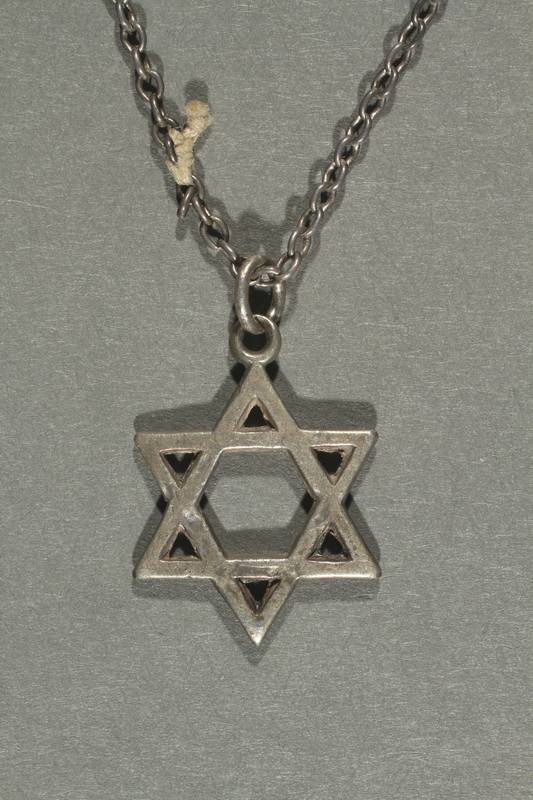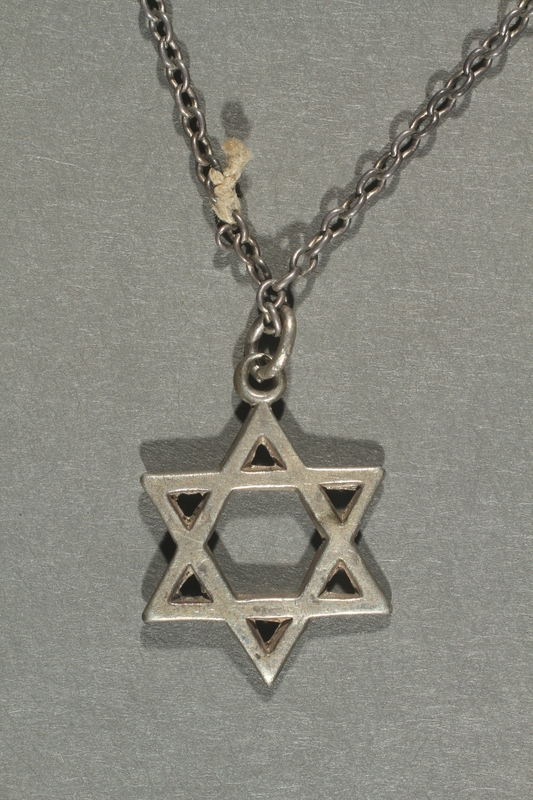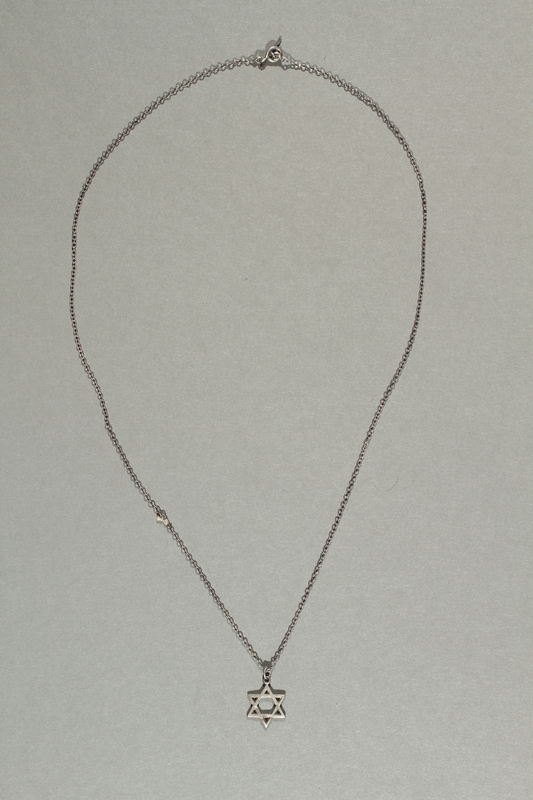Overview
- Brief Narrative
- Small Star of David pendant on a silver chain belonging to Margret Simon Hantman. There are small pieces of thread holding the links together where Margret repaired the broken chain. Prior to the war, Margret and her family lived in Berlin, Germany, where her father owned a grocery store. In 1935, his store was taken by the authorities after the Nuremberg Laws were passed and he was forced to work as a laborer on the outskirts of the city. In October 1942, her sister Eva was sent on a transport to Rīga, Latvia, where she was murdered. In December, Margret and her parents were sent to Theresienstadt ghetto-labor camp in Czechoslovakia. In September 1944, Margret’s father was sent to Auschwitz concentration camp in German occupied Poland, where he was murdered. The following month she and her mother were sent there as well. Margret’s mother was killed soon after they arrived. Margret was sent to a large room where she was forced to remove her clothes and give up her belongings. She hid this tiny Star of David on a chain and a small photo of her sister in her mouth. She kept the items there throughout the process of showering and having her hair shaved off. After a few weeks, Margret was sent to Sackisch‐Kudowa labor camp to work in an airplane factory. She and the other prisoners were freed in May 1945, and Margret made her way to Deggendorf displace persons camp that summer. She met her first husband Felix Huber at Deggendorf, and in 1946 they both immigrated to the United States.
- Date
-
use:
after 1926
- Geography
-
acquired:
Berlin (Germany)
use: Auschwitz (Concentration camp); Oświęcim (Poland)
- Credit Line
- United States Holocaust Memorial Museum Collection, Gift of Margret Hantman
- Contributor
-
Subject:
Margret Hantman
- Biography
-
Margret (Miriam) Hantman (née Simon) (b. 1926) was born in Berlin, Germany, to Willy Simon (1896-1944) and Ella Anita Stahl Simon (1901-1944). She had one younger sister, Eva (1928-1942). Her father ran a grocery store outside Berlin and made a comfortable living. On January 30, 1933, Adolf Hitler was appointed Chancellor of Germany and anti-Jewish decrees were passed that restricted every aspect of Jewish life. In 1935, her father’s store was taken from him by authorities after the Nuremberg Laws were passed. The family moved to Bernau, a small town north of Berlin. Her father worked as a salesman for a margarine company, but then was forced to do hard labor carrying stones. After a couple of years, the Simon family moved back to Berlin where Margret attended public school until she was forced, by law, to attend a Temple school for Jewish children only. Her family was not religious, but Margret became very interested in the Zionist movement and went away to a Hachshara in order to prepare to make aliyah to Palestine.
After returning to Berlin, Margret worked in a cable factory for six months. Her sister, Eva attended school and worked nights in a Jewish foundling home. In October 1942, the Gestapo, seeking retribution against members of the Jewish community who had gone underground, deported a group to Rīga, Latvia. Eva, who was working for the Jewish community, was taken away on this transport at the age of 15. In December, Margret and her parents received a transport summons as well. Her father had received the Iron Cross in WWI and her grandmother was not Jewish, so they were sent to Theresienstadt ghetto-labor camp in Czechsoslovakia. They were forced to live separately, but could see each other. Margret worked in the stabsgarten [staff garden] where they grew vegetables enabling her to sneak food to her family. In Theresienstadt, she met Lucy Steinhagen (née Fried), who became a lifelong friend. Margret’s father worked treating people who had lice and her mother did sewing.
In September 1944, her father was deported on a male only transport from Theresienstadt to Auschwitz concentration camp in German occupied Poland. Before he was taken, Margret promised him she would not leave her mother alone. In October, her mother was put on a transport and Margret went with her, even though her job exempted her from transports. When they arrived at Auschwitz, Margret’s mother broke down crying and they were separated. Margret was sent to a large room where she was forced to remove her clothes and give up her belongings. In order to not have to forfeit them, she hid her two prized possessions - a small photo of her sister and a tiny Star of David on a chain - in her mouth. She kept the items there throughout the process of showering and having her hair shaved off.
Margret was in Auschwitz for three weeks when she and the other prisoners were told to form two lines because they were being sent out of the camp. Next to her in line was a young woman who had a twin sister in the other line. The twins started to cry and Margret thought they should not be separated so she changed places with one of them. Afraid of being found out for switching places, she took the girl’s name, Eva Pollacova, and went by that name until the end of the war. Margret later found that the twins had been taken to another camp and survived. Margret was taken to Sackisch‐Kudowa labor camp, a sub-camp of Gross-Rosen concentration camp in Poland, on the border of Czechoslovakia. There she worked in an airplane factory. In May 1945, the German guards marched Margret and the other prisoners into Czechoslovakia where they were freed and taken in by local families. She was treated very well by the Czech family she stayed with. After the War, Margret went with a friend to Prague, then to a Zionist conference in Budapest, and finally made her way back to Theresienstadt, as she wanted to know for certain what had happened to her family. She found that her sister had perished in Riga and her mother and father had been murdered at Auschwitz.
In the summer of 1945, Margret made her way to Deggendorf displaced persons camp in Germany where she met her future husband, Felix Huber. Prior to Deggendorf, Felix (1913-1970) had been at a forced labor camp in Linden, Germany, Theresienstadt, and Auschwitz. While at Deggendorf, Margret was active in a theater group that put on productions at the camp. In May 1946, Margret and Felix boarded the small ship the Marine Perch and made their way to the United States. After a couple of weeks in New York, they made their way to Margret’s relatives in St. Louis, Missouri. Margret and Felix married a year and a half later and had two children. Felix Huber, passed away at age 57. She married her second husband Jack Hantman in 1971. Margret currently resides in New York.
Physical Details
- Classification
-
Jewelry
- Category
-
Necklaces
- Object Type
-
Necklaces (lcsh)
- Genre/Form
- Pendants (Jewelry) Magen David.
- Physical Description
- Silver colored metal, cable chain necklace with toggle clasp and 6 pointed Star of David pendant. The pendant is approximately ½” wide and is formed from two flat, overlapping open triangles. There is a small closed metal loop on the top point of the star connected to a small, circular bail on the chain. There is a break in the chain approximately 7.5” from the round end of the clasp that has been repaired with an off-white piece of thread.
- Dimensions
- overall: Height: 10.750 inches (27.305 cm) | Width: 1.500 inches (3.81 cm) | Depth: 0.500 inches (1.27 cm)
- Materials
- overall : metal, thread
Rights & Restrictions
- Conditions on Access
- No restrictions on access
- Conditions on Use
- No restrictions on use
Keywords & Subjects
- Topical Term
- Women concentration camp inmates--Poland. Holocaust, Jewish (1939-1945)--Personal narratives, German. World War, 1939-1945--Concentration camps--Poland. Concentration camp inmates--Poland--Auschwitz. Forced labor--Poland.
- Geographic Name
- Oświęcim (Poland)
- Corporate Name
- Auschwitz (Concentration camp)
Administrative Notes
- Legal Status
- Permanent Collection
- Provenance
- The chain and pendant were donated to the United States Holocaust Memorial Museum in 2018 by Margret Hantman.
- Record last modified:
- 2023-09-01 09:04:14
- This page:
- https://collections.ushmm.org/search/catalog/irn597312
Also in Margret Hantman collection
The collection consists of a dress, brassiere, Star of David pendant and badge, Theresienstadt scrip, commemorative pendant, documents, photographs, and a memoir relating to the experiences of Margret Hantman in Germany, Poland, Czechoslovakia, and the United States during and after the Holocaust.
Date: 1926-2010
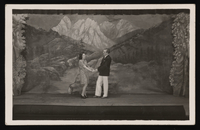
Margret Hantman papers
Document
The Margret Hantman papers include biographical material, Margret’s ten page memoir describing her Holocaust-era experiences in Germany and concentration camps, photographs of theatrical performances at the Deggendorf displaced persons camp, a Theresienstadt reunion program, and picture postcards of Theresienstadt. Biographical material includes Margret’s Czechoslovak Repatriation Office registration, instructions for sending mail to Deggendorf residents, and Margret’s passenger ticket for the Marine Perch. Margret’s ten page memoir describes her experiences growing up in Bernau and Berlin, training in a Zionist Hachshara camp, deportations to Theresienstadt, Auschwitz, and various labor camps, and postwar life at the Deggendorf displaced persons camp. Photographs depict theatrical performances at Deggendorf, and many picture Margret. In the first photographs, she is pictured second from right with Lucie Steinhagen dressed as the Statue of Liberty. In the second photograph, she is pictured holding an oversized ace of hearts. In the third photograph, she is pictured fourth from right dressed in male costume in a mountain scene. In the fourth photograph, she is pictured fourth from left in military uniform. In the fifth photograph, she is pictured third from right in a long dress. The collection also contains a program from a 30th anniversary Theresienstadt reunion in October 1975 and seven picture postcards depicting Theresienstadt.

Stars and stripes dress worn by a German Jewish woman for a DP camp theatrical performance
Object
Stars and stripes costume worn by Margret Simon Hantman in a musical revue at Deggendorf displaced persons (DP) camp. The costume was designed by a Viennese couple, most likely Paul and Erna Sucher, and was made in a sewing group. In order to stay busy and bring some normalcy to their lives after the war, Margret and her friends formed a theater group and staged productions at the camp. Prior to the war, Margret and her family lived in Berlin, Germany, where her father owned a grocery store. In 1935, his store was taken by the authorities after the Nuremberg Laws were passed and he was forced to work as a laborer on the outskirts of the city. In October 1942, her sister Eva was sent on a transport to Rīga, Latvia, where she was murdered. In December, Margret and her parents were sent to Theresienstadt ghetto-labor camp in Czechoslovakia. In September 1944, Margret’s father was sent to Auschwitz concentration camp in German occupied Poland, where he was murdered. The following month she and her mother were sent there as well. Margret’s mother was killed soon after they arrived. After a few weeks, Margret was sent to Sackisch‐Kudowa labor camp to work in an airplane factory. She and the other prisoners were freed in May 1945, and Margret made her way to Deggendorf DP camp that summer. She met her first husband Felix Huber at Deggendorf, and in 1946 they both immigrated to the United States.
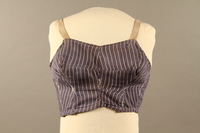
Brassiere made for a German Jewish woman in a forced labor camp
Object
Brassiere made for Margret Simon Hantman from a piece of her camp night shirt by a woman she shared a room with while imprisoned at Sackish-Kudowa labor camp from 1944-1945. Prior to the war, Margret and her family lived in Berlin, Germany, where her father owned a grocery store. In 1935, his store was taken by the authorities after the Nuremberg Laws were passed and he was forced to work as a laborer on the outskirts of the city. In October 1942, her sister Eva was sent on a transport to Rīga, Latvia, where she was murdered. In December, Margret and her parents were sent to Theresienstadt ghetto-labor camp in Czechoslovakia. In September 1944, Margret’s father was sent to Auschwitz concentration camp in German occupied Poland, where he was murdered. The following month she and her mother were sent there as well. Margret’s mother was killed soon after they arrived. After a few weeks, Margret was sent to Sackisch‐Kudowa labor camp to work in an airplane factory. She shared a room with eight other women. They all got along well and supported and tried to help one another. She and the other prisoners were freed in May 1945, and Margret made her way to Deggendorf displaced persons camp that summer. She met her first husband Felix Huber at Deggendorf, and in 1946 they both immigrated to the United States.
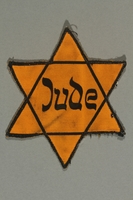
Star of David patch printed with Jude worn by a German Jewish woman
Object
Badge received by Margret Simon Hantman in 1941, after German authorities required all Jews to identify themselves by wearing the Star of David. Prior to the war, Margret and her family lived in Berlin, Germany, where her father owned a grocery store. In 1935, his store was taken by the authorities after the Nuremberg Laws were passed and he was forced to work as a laborer on the outskirts of the city. In October 1942, her sister Eva was sent on a transport to Rīga, Latvia, where she was murdered. In December, Margret and her parents were sent to Theresienstadt ghetto-labor camp in Czechoslovakia. In September 1944, Margret’s father was sent to Auschwitz concentration camp in German occupied Poland, where he was murdered. The following month she and her mother were sent there as well. Margret’s mother was killed soon after they arrived. After a few weeks, Margret was sent to Sackisch‐Kudowa labor camp to work in an airplane factory. She and the other prisoners were freed in May 1945 and Margret made her way to Deggendorf displaced persons camp that summer. She met her first husband Felix Huber at Deggendorf, and in 1946 they both immigrated to the United States.
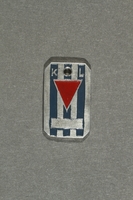
Commemorative concentration camp pendant owned by a German Jewish woman
Object
Small silver and enamel commemorative concentration camp pendant worn postwar by Margret Simon Hantman. The pendant has an inverted red triangle on a blue and gray striped field representing concentration camp uniforms. It is likely that Margret obtained this while at Deggendorf displaced persons (DP) camp. Prior to the war, Margret and her family lived in Berlin, Germany, where her father owned a grocery store. In 1935, his store was taken by the authorities after the Nuremberg Laws were passed and he was forced to work as a laborer on the outskirts of the city. In October 1942, her sister Eva was sent on a transport to Rīga, Latvia, where she was murdered. In December, Margret and her parents were sent to Theresienstadt ghetto-labor camp in Czechoslovakia. In September 1944, Margret’s father was sent to Auschwitz concentration camp in German occupied Poland, where he was murdered. The following month she and her mother were sent there as well. Margret’s mother was killed soon after they arrived. After a few weeks, Margret was sent to Sackisch‐Kudowa labor camp to work in an airplane factory. She and the other prisoners were freed in May 1945, and Margret made her way to Deggendorf DP camp that summer. She met her first husband Felix Huber at Deggendorf, and in 1946 they both immigrated to the United States.
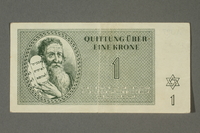
Theresienstadt ghetto-labor camp scrip, 1 krone note issued to a German Jewish inmate
Object
Scrip, valued at one krone, issued to Margret Simon Hantman in Theresienstadt ghetto-labor camp in Czechoslovakia between May 1943 and October 1944. Currency was confiscated from new inmates and replaced with scrip like this, which could only be used in the camp. Prior to the war, Margret and her family lived in Berlin, Germany, where her father owned a grocery store. In 1935, his store was taken by the authorities after the Nuremberg Laws were passed and he was forced to work as a laborer on the outskirts of the city. In October 1942, her sister Eva was sent on a transport to Rīga, Latvia, where she was murdered. In December, Margret and her parents were sent to Theresienstadt. They were forced to live separately, but could see each other. Margret worked in the stabsgarten [staff garden] where they grew vegetables enabling her to sneak food to her family. Margret’s father worked treating people who had lice and her mother did sewing. In September 1944, Margret’s father was sent to Auschwitz concentration camp in German occupied Poland, where he was murdered. The following month she and her mother were sent there as well. Margret’s mother was killed soon after they arrived. After a few weeks, Margret was sent to Sackisch‐Kudowa labor camp to work in an airplane factory. She and the other prisoners were freed in May 1945, and Margret made her way to Deggendorf displaced persons camp that summer. She met her first husband Felix Huber at Deggendorf, and in 1946 they both immigrated to the United States.
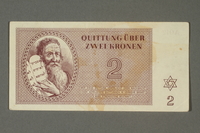
Theresienstadt ghetto-labor camp scrip, 2 kronen note, issued to a German Jewish inmate
Object
Scrip, valued at two kronen, issued to Margret Simon Hantman in Theresienstadt ghetto-labor camp in Czechoslovakia between May 1943 and October 1944. Currency was confiscated from new inmates and replaced with scrip like this, which could only be used in the camp. Prior to the war, Margret and her family lived in Berlin, Germany, where her father owned a grocery store. In 1935, his store was taken by the authorities after the Nuremberg Laws were passed and he was forced to work as a laborer on the outskirts of the city. In October 1942, her sister Eva was sent on a transport to Rīga, Latvia, where she was murdered. In December, Margret and her parents were sent to Theresienstadt. They were forced to live separately, but could see each other. Margret worked in the stabsgarten [staff garden] where they grew vegetables enabling her to sneak food to her family. Margret’s father worked treating people who had lice and her mother did sewing. In September 1944, Margret’s father was sent to Auschwitz concentration camp in German occupied Poland, where he was murdered. The following month she and her mother were sent there as well. Margret’s mother was killed soon after they arrived. After a few weeks, Margret was sent to Sackisch‐Kudowa labor camp to work in an airplane factory. She and the other prisoners were freed in May 1945, and Margret made her way to Deggendorf displaced persons camp that summer. She met her first husband Felix Huber at Deggendorf, and in 1946 they both immigrated to the United States.
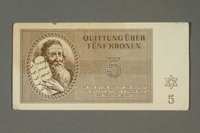
Theresienstadt ghetto-labor camp scrip, 5 kronen note, issued to a German Jewish inmate
Object
Scrip, valued at five kronen, issued to Margret Simon Hantman in Theresienstadt ghetto-labor camp in Czechoslovakia between May 1943 and October 1944. Currency was confiscated from new inmates and replaced with scrip like this, which could only be used in the camp. Prior to the war, Margret and her family lived in Berlin, Germany, where her father owned a grocery store. In 1935, his store was taken by the authorities after the Nuremberg Laws were passed and he was forced to work as a laborer on the outskirts of the city. In October 1942, her sister Eva was sent on a transport to Rīga, Latvia, where she was murdered. In December, Margret and her parents were sent to Theresienstadt. They were forced to live separately, but could see each other. Margret worked in the stabsgarten [staff garden] where they grew vegetables enabling her to sneak food to her family. Margret’s father worked treating people who had lice and her mother did sewing. In September 1944, Margret’s father was sent to Auschwitz concentration camp in German occupied Poland, where he was murdered. The following month she and her mother were sent there as well. Margret’s mother was killed soon after they arrived. After a few weeks, Margret was sent to Sackisch‐Kudowa labor camp to work in an airplane factory. She and the other prisoners were freed in May 1945, and Margret made her way to Deggendorf displaced persons camp that summer. She met her first husband Felix Huber at Deggendorf, and in 1946 they both immigrated to the United States.
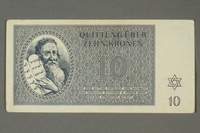
Theresienstadt ghetto-labor camp scrip, 10 kronen note, issued to a German Jewish inmate
Object
Scrip, valued at ten kronen, issued to Margret Simon Hantman in Theresienstadt ghetto-labor camp in Czechoslovakia between May 1943 and October 1944. Currency was confiscated from new inmates and replaced with scrip like this, which could only be used in the camp. Prior to the war, Margret and her family lived in Berlin, Germany, where her father owned a grocery store. In 1935, his store was taken by the authorities after the Nuremberg Laws were passed and he was forced to work as a laborer on the outskirts of the city. In October 1942, her sister Eva was sent on a transport to Rīga, Latvia, where she was murdered. In December, Margret and her parents were sent to Theresienstadt. They were forced to live separately, but could see each other. Margret worked in the stabsgarten [staff garden] where they grew vegetables enabling her to sneak food to her family. Margret’s father worked treating people who had lice and her mother did sewing. In September 1944, Margret’s father was sent to Auschwitz concentration camp in German occupied Poland, where he was murdered. The following month she and her mother were sent there as well. Margret’s mother was killed soon after they arrived. After a few weeks, Margret was sent to Sackisch‐Kudowa labor camp to work in an airplane factory. She and the other prisoners were freed in May 1945, and Margret made her way to Deggendorf displaced persons camp that summer. She met her first husband Felix Huber at Deggendorf, and in 1946 they both immigrated to the United States.
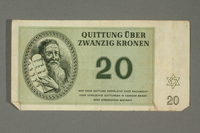
Theresienstadt ghetto-labor camp scrip, 20 kronen note, issued to a German Jewish inmate
Object
Scrip, valued at twenty kronen, issued to Margret Simon Hantman in Theresienstadt ghetto-labor camp in Czechoslovakia between May 1943 and October 1944. Currency was confiscated from new inmates and replaced with scrip like this, which could only be used in the camp. Prior to the war, Margret and her family lived in Berlin, Germany, where her father owned a grocery store. In 1935, his store was taken by the authorities after the Nuremberg Laws were passed and he was forced to work as a laborer on the outskirts of the city. In October 1942, her sister Eva was sent on a transport to Rīga, Latvia, where she was murdered. In December, Margret and her parents were sent to Theresienstadt. They were forced to live separately, but could see each other. Margret worked in the stabsgarten [staff garden] where they grew vegetables enabling her to sneak food to her family. Margret’s father worked treating people who had lice and her mother did sewing. In September 1944, Margret’s father was sent to Auschwitz concentration camp in German occupied Poland, where he was murdered. The following month she and her mother were sent there as well. Margret’s mother was killed soon after they arrived. After a few weeks, Margret was sent to Sackisch‐Kudowa labor camp to work in an airplane factory. She and the other prisoners were freed in May 1945, and Margret made her way to Deggendorf displaced persons camp that summer. She met her first husband Felix Huber at Deggendorf, and in 1946 they both immigrated to the United States.

Theresienstadt ghetto-labor camp scrip, 50 kronen note, issued to a German Jewish inmate
Object
Scrip, valued at fifty kronen, issued to Margret Simon Hantman in Theresienstadt ghetto-labor camp in Czechoslovakia between May 1943 and October 1944. Currency was confiscated from new inmates and replaced with scrip like this, which could only be used in the camp. Prior to the war, Margret and her family lived in Berlin, Germany, where her father owned a grocery store. In 1935, his store was taken by the authorities after the Nuremberg Laws were passed and he was forced to work as a laborer on the outskirts of the city. In October 1942, her sister Eva was sent on a transport to Rīga, Latvia, where she was murdered. In December, Margret and her parents were sent to Theresienstadt. They were forced to live separately, but could see each other. Margret worked in the stabsgarten [staff garden] where they grew vegetables enabling her to sneak food to her family. Margret’s father worked treating people who had lice and her mother did sewing. In September 1944, Margret’s father was sent to Auschwitz concentration camp in German occupied Poland, where he was murdered. The following month she and her mother were sent there as well. Margret’s mother was killed soon after they arrived. After a few weeks, Margret was sent to Sackisch‐Kudowa labor camp to work in an airplane factory. She and the other prisoners were freed in May 1945, and Margret made her way to Deggendorf displaced persons camp that summer. She met her first husband Felix Huber at Deggendorf, and in 1946 they both immigrated to the United States.
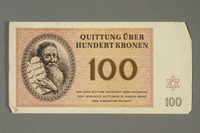
Theresienstadt ghetto-labor camp scrip, 100 kronen note, issued to a German Jewish inmate
Object
Scrip, valued at one hundred kronen, issued to Margret Simon Hantman in Theresienstadt ghetto-labor camp in Czechoslovakia between May 1943 and October 1944. Currency was confiscated from new inmates and replaced with scrip like this, which could only be used in the camp. Prior to the war, Margret and her family lived in Berlin, Germany, where her father owned a grocery store. In 1935, his store was taken by the authorities after the Nuremberg Laws were passed and he was forced to work as a laborer on the outskirts of the city. In October 1942, her sister Eva was sent on a transport to Rīga, Latvia, where she was murdered. In December, Margret and her parents were sent to Theresienstadt. They were forced to live separately, but could see each other. Margret worked in the stabsgarten [staff garden] where they grew vegetables enabling her to sneak food to her family. Margret’s father worked treating people who had lice and her mother did sewing. In September 1944, Margret’s father was sent to Auschwitz concentration camp in German occupied Poland, where he was murdered. The following month she and her mother were sent there as well. Margret’s mother was killed soon after they arrived. After a few weeks, Margret was sent to Sackisch‐Kudowa labor camp to work in an airplane factory. She and the other prisoners were freed in May 1945, and Margret made her way to Deggendorf displaced persons camp that summer. She met her first husband Felix Huber at Deggendorf, and in 1946 they both immigrated to the United States.
Portrait of a German Jewish girl in a handmade burlap frame
Object
Framed, black and white, photographic portrait of Eva Simon, the sister of Margret Simon Hantman. The photograph was given to her in Berlin before the war. The frame was made from a piece of coarse mattress by a woman Margret shared a room with while imprisoned at Sackish-Kudowa labor camp. Prior to the war, Margret and her family lived in Berlin, Germany, where her father owned a grocery store. In 1935, his store was taken by the authorities after the Nuremberg Laws were passed and he was forced to work as a laborer on the outskirts of the city. In October 1942, her sister Eva was sent on a transport to Rīga, Latvia, where she was murdered. In December, Margret and her parents were sent to Theresienstadt ghetto-labor camp in Czechoslovakia. In September 1944, Margret’s father was sent to Auschwitz concentration camp in German occupied Poland, where he was murdered. The following month she and her mother were sent there as well. Margret’s mother was killed soon after they arrived. Margret was sent to a large room where she was forced to remove her clothes and give up her belongings. She hid this small photo of her sister and a tiny Star of David on a chain in her mouth. She kept the items there throughout the process of showering and having her hair shaved off. After a few weeks, Margret was sent to Sackisch‐Kudowa labor camp to work in an airplane factory. She and the other prisoners were freed in May 1945, and Margret made her way to Deggendorf displaced persons camp that summer. She met her first husband Felix Huber at Deggendorf, and in 1946 they both immigrated to the United States.

